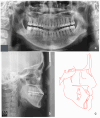Management of Class III Malocclusion with Microimplant-Assisted Rapid Palatal Expansion (MARPE) and Mandible Backward Rotation (MBR): A Case Report
- PMID: 39459375
- PMCID: PMC11509630
- DOI: 10.3390/medicina60101588
Management of Class III Malocclusion with Microimplant-Assisted Rapid Palatal Expansion (MARPE) and Mandible Backward Rotation (MBR): A Case Report
Abstract
Class III malocclusion prevalence varies significantly among racial groups, with the highest prevalence observed in southeast Asian populations at 15.80%. These malocclusions often involve maxillary retrognathism, mandibular prognathism, or both, accompanied by maxillary constriction and crossbites. Comprehensive treatment should address anteroposterior, transverse, and vertical imbalances. Microimplant-assisted rapid palatal expansion (MARPE) has shown high success rates for transverse maxillary expansion in late adolescents and adults, presenting a viable alternative to surgically-assisted rapid palatal expansion (SARPE). This case report aims to demonstrate the successful treatment of a young adult female with borderline Class III malocclusion using MARPE and mandibular backward rotation (MBR) techniques. A 21-year-old female presented with a Class III skeletal pattern, anterior/posterior crossbites, and mild dental crowding. Despite her concerns about a concave facial profile, the patient declined orthognathic surgery due to a negative experience reported by a friend. The treatment plan included MARPE to correct maxillary transverse deficiency and MBR to alleviate Class III malocclusion severity. Lower arch distalization was performed using temporary anchorage devices (TADs) on the buccal shelves, and Class II elastics were used to maintain MBR and prevent retroclination of the lower labial segment during anterior retraction. Significant transverse correction was achieved, and the severity of Class III malocclusion was reduced. The lower dentition was effectively retracted, and the application of Class II elastics helped maintain MBR. The patient's final facial profile was harmonious, with well-aligned dentition and a stable occlusal relationship. The treatment results were well-maintained after one year. The MARPE with MBR approach presents a promising alternative for treating borderline Class III cases, particularly for patients reluctant to undergo orthognathic surgery. This case report highlights the effectiveness of combining MARPE and MBR techniques in achieving stable and satisfactory outcomes in the treatment of Class III malocclusion.
Keywords: Class III malocclusion; mandibular backward rotation; microimplant-assisted rapid palatal expansion.
Conflict of interest statement
The authors declare no conflicts of interest.
Figures












Similar articles
-
Management of Class III Malocclusion and Maxillary Transverse Deficiency with Microimplant-Assisted Rapid Palatal Expansion (MARPE): A Case Report.Medicina (Kaunas). 2022 Aug 4;58(8):1052. doi: 10.3390/medicina58081052. Medicina (Kaunas). 2022. PMID: 36013519 Free PMC article.
-
Management of anterior and posterior crossbites with lingual appliances and miniscrew-assisted rapid palatal expansion: A case report.Medicine (Baltimore). 2024 Dec 6;103(49):e40832. doi: 10.1097/MD.0000000000040832. Medicine (Baltimore). 2024. PMID: 39654233 Free PMC article.
-
Intermaxillary elastics on skeletal anchorage and MARPE to treat a class III maxillary retrognathic open bite adolescent: A case report.Int Orthod. 2021 Dec;19(4):707-715. doi: 10.1016/j.ortho.2021.08.001. Epub 2021 Aug 25. Int Orthod. 2021. PMID: 34452857
-
Clinical applications of miniscrews that broaden the scope of non-surgical orthodontic treatment.Orthod Craniofac Res. 2021 Mar;24 Suppl 1:48-58. doi: 10.1111/ocr.12452. Epub 2020 Dec 14. Orthod Craniofac Res. 2021. PMID: 33275826 Review.
-
Realities of craniofacial growth modification.Atlas Oral Maxillofac Surg Clin North Am. 2001 Mar;9(1):23-51. Atlas Oral Maxillofac Surg Clin North Am. 2001. PMID: 11905336 Review.
Cited by
-
The Therapeutic Approaches Dealing with Malocclusion Type III-Narrative Review.Life (Basel). 2025 May 22;15(6):840. doi: 10.3390/life15060840. Life (Basel). 2025. PMID: 40566493 Free PMC article. Review.
References
-
- Hardy D.K., Cubas Y.P., Orellana M.F. Prevalence of angle class III malocclusion: A systematic review and meta-analysis. Open J. Epidemiol. 2012;2:75–82. doi: 10.4236/ojepi.2012.24012. - DOI
-
- McNamara J.A., Jr. An orthopedic approach to the treatment of Class III malocclusion in young patients. J. Clin. Orthod. 1987;21:598–608. - PubMed
Publication types
MeSH terms
LinkOut - more resources
Full Text Sources

